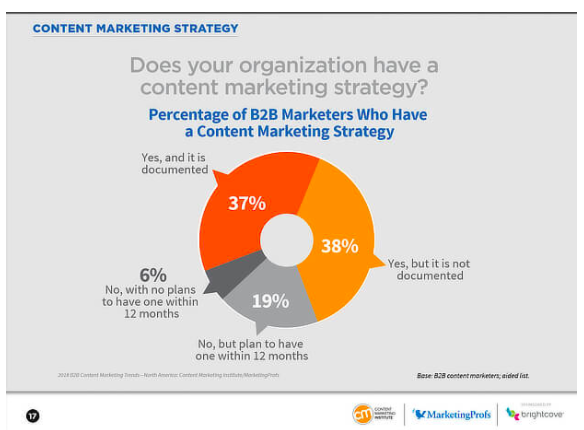How do I put together a content strategy?
As many as 63% of businesses don’t have a documented content marketing strategy. This means no defined goals, no ideas for how to implement them, and no organized way to analyse the results and evolve their strategy.

This is a statistic that’s really surprising to me—especially since I believe it’s vital to map everything out and make sure plans are specific, measurable, achievable, and time-bound (i.e. SMART goals).
That said, it did take a while for me to learn how to create an effective content strategy and plan. To get you started with a framework to build your own strategy, here are some guidelines and tips:
1. Anchor Your Strategy to Your Mission and Goals
Any campaign that you’re working on should have a clear mission and a defined set of goals that you’re working towards (remember, make them SMART). This will help immensely in keeping you focused on what’s important so you can keep your content strategy on track.
2. Set your KPIs
Key performance indicators (KPIs) have to be set so you know what elements to track as a measure of success. What milestones will indicate that you’ve successfully completed one stage and are ready to move on to the next? What metrics do you have to monitor to ensure that you reach targets? Setting these KPIs early means you know exactly what you’re working towards and it will go a long way towards keeping you focused.
3. Get to Know Your Audience
The success of your content strategy hinges on how well your audience responds to it, engages with your content, and acts on it. This means you have to get to know your audience inside and out. I recommend collecting demographic data such as age, gender, education, and income by doing research. Understanding their psychographic data means you can create detailed buyer personas to illustrate your ideal customer and target your content better.
4. Do an Audit of Where You Currently Stand
It’s very likely that you already have some sort of content marketing efforts in place. You probably have blog posts, artwork you can use for content, podcasts, videos, etc. Conduct an internal audit and take the time to understand exactly whether or not they will be useful as you try to move forward with your content strategy. Laying everything out will help you determine which content you still need to produce and create, what resources you need, and how to allocate your budget.
5. Set a Realistic Budget
Speaking of budgets, be realistic about what you can and cannot do with yours as part of your strategy. If you can only afford to implement your content strategy with very little money, knowing this from the get-go is important. You can’t allocate a significant amount towards ads when you don’t have the resources for it. This will only result in your strategy failing. Don’t worry—the great thing about content marketing is that budgets are easily scalable. Once you get significant ROI from your efforts, it’s easy to scale your efforts up to reach a wider audience.
There you have it. Hope my answer helps! Comments and questions are welcome in the comment section below. You can also reach out to me personally via email at Leadspanda.
Share This Story
Get the latest growth ideas, strategies, and best practices delivered to your inbox.
Quick read that helps 7000+ subscribers.






